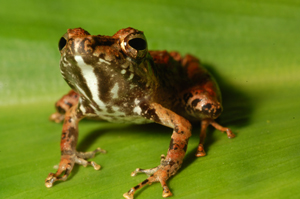Photographs from a field trip to Ecuador (July-August 2008)
Andean and Amazonian Reptiles
Yasuni National Park Field Trip (eastern Amazonia, Orellana Province)
Atelopus sp. Field Trip (southern Andes, Morona Province)
Pontifical Universidad Católica del Ecuador (PUCE) Endangered Frog Colony
Andean and Amazonian Reptiles
 |
|
Potamites ecpleopus |
 |
|
Anolis fuscoauratus |
 |
|
Gonatodes humeralis |
 |
|
Gonatodes humeralis |
 |
|
Leptodeira annulata |
 |
|
Lepidoblepharis festo |
 |
|
Potamites sp. |
Yasuni National Park (Orellana Province)
 |
|
Amazonian rainforest |
 |
|
Yasuni Research Station (PUCE) |
 |
|
Yasuni Research Station (PUCE) |
 |
|
This tapir is a resident of Yasuni Research Station. |
 |
|
A view of the canopy from below. |
 |
|
Thick forest around Yasuni Research Station. |
 |
|
Rio Tiputini flowing past Yasuni Research Station. |
 |
|
Fearless collaborator Santiago Ron (he committed a felony while working on a master's degree in Kansas). |
 |
|
Bolitoglossa peruviana |
 |
|
Chiasmocleis bassleri |
 |
|
Chiasmocleis bassleri (venter) |
 |
|
Leptodactylus andreae |
 |
|
Leptodactylus pentadactylus |
 |
|
Hypodactylus nigrovittatus |
 |
|
Pristimantis lanthanites |
 |
|
Pristimantis acuminatus |
 |
|
Pristimantis conspicillatus |
 |
|
Pristimantis kichwarum |
 |
|
Pristimantis martiae |
 |
|
Pristimantis sp. |
 |
|
Allobates insperatus |
 |
|
Amereega bilinguis |
 |
|
Ranitomeya duellmani |
 |
|
Edalorhina perezi |
 |
|
Rhinella dapsilis |
 |
|
Rhinella margaretifera |
 |
|
Dendropsophus bifurcus |
 |
|
Dendropsophus parviceps |
 |
|
Hypsiboas calcaratus |
 |
|
Hypsiboas geographicus |
 |
|
Hypsiboas granosus |
 |
|
Hypsiboas lanciformis |
 |
|
Osteocephalis planiceps |
 |
|
Osteocephalis yasuni |
 |
|
Scinax ruber |
 |
|
Phyllomedusa vaillanti |
 |
|
A bird's eye view of Amazonia |
Site of Atelopus sp. Field Trip (Morona Province
PUCE Endangered Frog Colony
As a result of rapid declines in approximately 30% of Ecuador's frog species, researchers at PUCE started a captive colony to preserve the most highly endangered species. They are currently trying identify the environmental cues that will stimulate the frogs to breed in captivity. If successful, PUCE researchers hope to reintroduce these frogs to their natural habitat someday.
|

